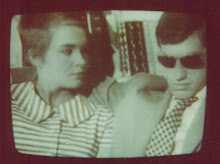
Most of the films have been shown within few short blocks in the historic town of Telluride. The local schools have high-end screening auditoriums. The center of town features an outdoor screening area One large theater is up the mountain by gondola. During the hours of 8am and 12am the film schedule rolls onward for an endless possibility of viewing.
Despite the beauty and fun of it all, walking about the hilly streets in the dry high altitudes is not for the weary. There are plenty of generic gearless bicycles around for those who prefer riding...no locks required. Some people around town have artfully painted versions with color and pattern. I did notice locks on some of those.
The daily schedule is key. Multiple films of interest have overlapping times. Arriving early to line up for seating is the pesky part of the scheduling process, but people are friendly and chatting in line is part of the experience. After waiting nearly an hour to get into the tribute show last night in an auditorium big eough for 650 people, we just made it and ended up high in the balcony. Other theaters seat only fifty so those show fill up quickly.
This is a celebration of
the dark theater of memory (Dennis Jakob). There will be plenty of time later for the peaceful home-viewing or the ease of my local hometown theaters--never a line--just walk into any top independent film on a wednesday evening and find just a few other people.
The beauty of this experience is having the director and many of the actors present, Q & A sessions, chance encounters. The two tribute shows reminded me of so many films that I would like to see again. The director of
Cameraman sat next to Kerry and I at a cafe and we learned about his study of a cameraman who worked in the industry for more than seventy years. I listened to Mark Cousins explain how his early childhood in Belfast during the war "tenderized" him to become a filmmaker delivering imagination and art to children in a small village in Iraq.
Aron Ralston was an ordinary young man whose hiking adventure several years ago became the subject of Danny Boyle's recent film,
127 Hours, starring James Franco. All three were present for an outdoor panel to speak about how the tragic story was transformed into a film about survival and hope. I plan to see it this evening. During the first three days, I have seen...
Inside Job (Charles Ferguson)
A Tribute to Peter Weir
The Way Back (Peter Weir)
The Cameraman: The Life & Work of Jack Cardiff (Craig McCall)
Bieutiful (Alejandro Gonzalez Innaritu with Javier Bardem)
Seminar: Human/Nature with Danny Boyle, James Franco, Peter Weir, Werner Herzog
Dennis Jakob Unplugged (Errol Morris)
The First Movie (Mark Cousins)
Tribute to Colin Firth
The King's Speech (Tom Hooper with Colin Firth and Geoffrey Rush)
Last day here...more movies and more details to follow.
 October 1-10, 2010
October 1-10, 2010





